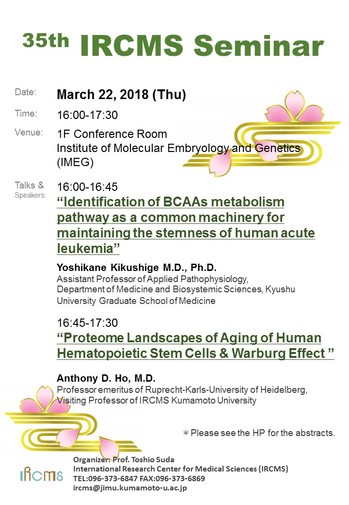- HOME
- IRCMS Seminars
- 35th IRCMS Seminar
IRCMS Seminars
35th IRCMS Seminar
March 12 2018
We would like to inform you that the 35th IRCMS Seminar has been scheduled as below. We would be pleased to see many of you participating in the seminar.
Date : March 22, 2018 (Thu)
Time : 16:00 - 17:30
Venue : 1F Conference Room, Institute of Molecular Embryology and Genetics (IMEG)
Talks & Speakers:
"Identification of BCAAs metabolism pathway as a common machinery for maintaining the stemness of human acute leukemia"
Yoshikane Kikushige M.D., Ph.D.
Assistant Professor of Applied Pathophysiology,
Department of Medicine and Biosystemic Sciences, Kyushu University Graduate School of Medicine
Recent technical advances in measuring cellular metabolites have revealed that several specific metabolism pathways actively contribute to the maintenance of cellular function in several types of stem cells such as ES cells, iPS cells and tissue stem cells including HSCs. The alteration of metabolism pathways changes the cellular content of specific metabolites, and in deed some metabolites regulate cell fate decision process of stem cells by modifying the epigenetic status of target genes. Thus, the activity of metabolism pathway and cellular content of metabolites should be a critical regulator of stem cell properties. In this study, we comprehensively analyzed cellular metabolites of human undifferentiated CD34+ normal HSPCs and AML cells to test whether specific metabolic pathways or metabolites could govern the maintenance of immature status and stem cell properties of human acute leukemia. We found CD34+ AML cells exhibited the significantly higher cellular contents of BCAAs as compared to normal CD34+ HSPCs. The immature CD34+ AML cells highly expressed BCAAs transporters and BCAT1, one of the critical molecules for BCAA metabolism pathways, indicating the enhanced BCAA uptake and active BCAA metabolism in the immature CD34+ immature leukemia cells. BCAT1 inhibition induced cellular apoptosis of CD34+ AML cells, but not in CD34+ normal HSPCs. Furthermore, the dietary restriction of BCAAs led to the attenuated leukemia propagation of AML via loss of stem cell-like immature cell fraction. This study provides the novel evidence that human acute leukemia cells actively utilize BCAA metabolism pathways to maintain the malignant stem cell properties through the regulation of specific epigenetic modification machineries.
"Proteome Landscapes of Aging of Human Hematopoietic Stem Cells & Warburg Effect "
Anthony D. Ho, M.D.
Professor emeritus of Ruprecht-Karls-University of Heidelberg,
Visiting Professor of IRCMS Kumamoto University
Background: Diminishing potential to replace damaged tissues is a hallmark for aging of somatic stem cells. To acquire a systems understanding of the human bone marrow cellular network as a model for somatic stem cells during the aging process, we have studied the alterations in proteome landscapes of human hematopoietic stem and progenitor cells (HSPC, CD34+ cells) in comparison to those of five other cellular elements comprising the bone marrow niche.
Methods: By studying the primary cells from 59 healthy human subjects within the age range from 20 to 60 years, we have generated a proteome-wide atlas of age-dependent alterations in human HSPC and other cell types constituting the niche. For each sample and cell type, the changes in abundance of between ~7,000 to ~12,000 proteins were assessed.
Results: A significant increase in abundance of proteins and enzymes associated with glycolysis, glycogen catabolism, fatty acid oxidation (FAO), acetyl-CoA metabolism, enzymes involved in elimination of nitric oxide (NO) was found as the HSPCs became older. The alterations in pathways of central carbon metabolism in the HSPC exhibited prominent features reminiscent of the Warburg effect where glycolytic intermediates are rerouted towards anabolism. In addition, aging caused significant alterations in the bone marrow niche, especially of the mesenchymal stromal cells (MSC), e.g. decreased functionality of the pathways involved in homing of HSPC. Numerous complementary alterations (age-related receptor-ligand changes) between MSC and HSPC were found. Whereas expression of NO synthase inhibitor (NOSIP) was significantly decreased in aging MSC, the downstream signaling effectors of NO, e.g. the heterodimeric soluble guanylyl cyclase (GUCY1A3 and GUCY1B3), were all elevated in older HSPC. These complementary changes highlight the importance of profiling the entire niche other than the HSPC. All age dependent alterations found in various mouse models described could be validated at a proteomics level in this comprehensive study.
Conclusions: We have captured for the first time the proteomic signatures of the aging process in human bone marrow. The novel findings of re-wiring of central carbon metabolism towards anabolism is closely associated with the lineage skewing towards myeloid development at the expense of lymphoid differentiation. This finding supports the notion that elevated energy and metabolite production is channeled into clonal hematopoiesis of indeterminate potential (CHIP) towards myeloid expansion of specific HSPC clones with age. Intervention into the metabolic pathways through nutritional or therapeutic measures might have a significant impact in the aging process of somatic stem cells.

